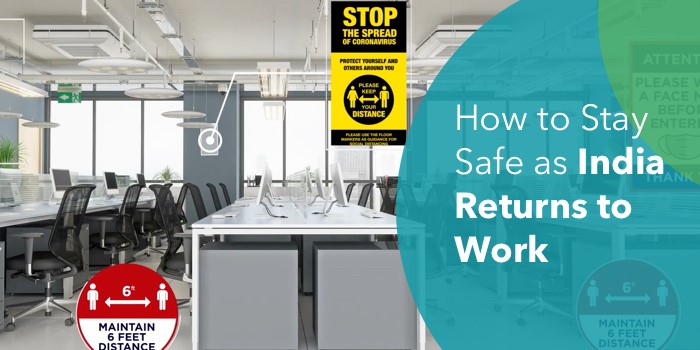Blogs How to Stay Safe as India Returns to Work
Blogs How to Stay Safe as India Returns to Work

The Covid-19 is a tricky guest! It does not only spread through unsuspecting carriers but it also lurks on surfaces from where it can spread to the next host. However, there are strategies that if properly applied can go a long way in keeping the virus at bay. As India is preparing to return to business as usual and employees prepare to return back to work, let us take a look at the four strategies recommended by US based surgeon Atul Gawande, together with a fifth and an even more important factor on which the success of the first four rest.
The four pillars to support return to work
If you want to learn about workplace safety protocols then hospitals are a good place. Medical workers and staff have been in the thick of the pandemic and the measures undertaken by them to prevent the transmission stand as an example for others. These four pillars by now are recognized as a common practice all across the world and workplaces need to ensure that they adhere to these closely. Gawande, in his article in the New Yorker magazine has said that these four pillars will not help us return to normal life, instead, when the signs indicate that the virus has come under control, these could actually get people out of their homes and moving all over again.
Social distancing
As the novel coronavirus primarily spreads through respiratory droplets which are released when people cough, sneeze and talk and even just breathe, physical distancing norms are considered important with at least a meter gap between people who are outside of their homes. A few hospitals in India have now limited the entry of four people at a time in the elevators that could easily carry twenty. Meetings have also been transformed mostly into virtual video conferences. In situations where they cannot avoid any face to face conversations, they have put up barriers and spaced out the workstation chairs farther.
Basic hygiene
Several advisories on hand washing suggest that we need to wash our hands for at least twenty seconds which would include a thorough rubbing of fingers, wrists, palms and nails. Recent studies however stressed on frequency. A recent study shows that by washing hands five times a day, you can cut down your visit to the hospital on grounds of respiratory infections by at least 45 percent. In 2002, during the SARS outbreak it was found out that washing hands more than ten times a day highly reduced the risks of the infection. Everyone must wash their hands every time they enter and exit any group setting and in every couple of hours while they are in that particular setting. Disinfecting the high touch panels also needs to be done at least once daily.
Screening
Screening measures before entering a facility or any public space has begun all across the country. All employees are required to be scanned at the door. Even better, employees need to confirm in an online form that they have not developed signs of the virus before they enter the office. Though this type of self screening isn’t a foolproof measure as people can easily lie, yet such regular check ins will encourage employees to report symptoms to not begin receiving the treatment but also to keep their colleagues and families safe.
Masks
The asymptomatic transmission and the danger that it poses implies that the three pillars above aren’t really enough. Wearing a mask ensures a source control that prevents the respiratory droplets from spreading infection without the knowledge of the individual . A recent study states that when surgical masks are worn properly, they can block around 99 percent of the droplets released by the people having the virus. Homemade masks were also found to be effective blocking at least 60 percent of the viral transmission. These masks aren’t too tight fitting and you can breathe in air entering through the sides. However, these masks are intended to help protect others and not the wearer. Now people have become highly concerned with keeping others safe as well and they are taking the risks of the virus seriously. Workplaces need to encourage this behaviour too.
What do you do if a staff tests positive?
Despite undertaking all the measures, an employee might still test positive. There is no need to close down your entire office building if one or two of your staff test positive, is what the latest central guidelines state. If there is a larger outbreak that involves multiple employees, the entire building needs to kept closed for 48 hours post disinfection. If one to two employees are affected, disinfection process needs to be carried out for 48 hours in places where the patient visited and post that work can be resumed. In the second case, all the staff are to work from home till he building has been properly disinfected and deemed fit for reoccupation, as per the guideline. When an employee develops a symptom, the offices are required to keep him in an isolated room and call 1075 immediately. In case of mild symptoms, he will be kept in home isolation. Those with mild to moderate symptoms will need to be shifted to Covid care centres or hospitals.
As India prepares to step into the new normal and we step out of our homes, we need to ensure that we have taken all the necessary measures and are self aware. In the wake of the pandemic and getting back to normal, ARC has introduced a wide suite of Covid-19 safety graphics and posters to help businesses convey safety and health and wellness measures.
Fill up the details below
Fill up the details below
Fill up the details below